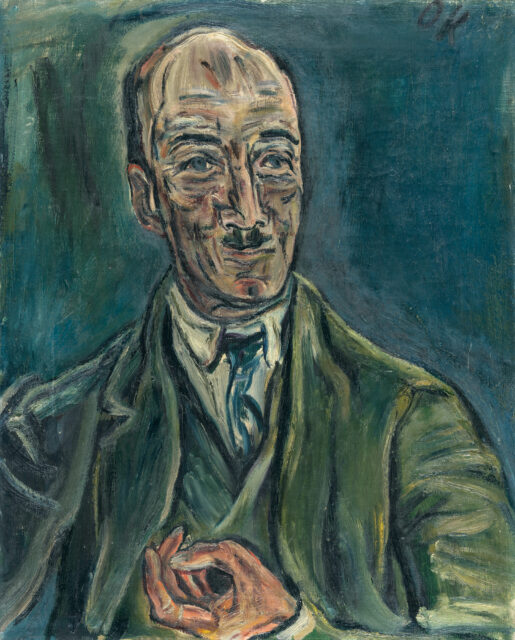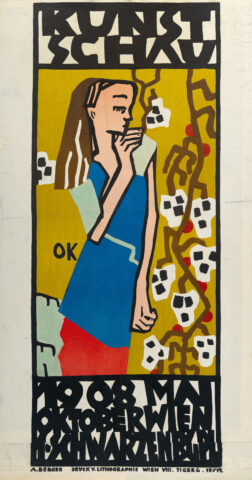
Victor Ritter von Bauer (Mr Bauer)
Details
With various hand-written notes and (remnants of) labels on the reverse. Wingler 101; Winkler/Erling 110. This work is listed in the Catalogue Raisonné of the Fondation Oskar Kokoschka under the number 1914/9 (https://www.oskar-kokoschka.ch). Literature: Brochure of G.I.N. Gallery, Amsterdam, on occasion of the exhibition Oskar Kokoschka, Schilderijen, tekeningen, aquarellen, grafiek, (undated/1970), with col. illus.; Hoffmann, Edith, Kokoschka. Life and Work, London 1947, no. 93, p. 303. Exhibitions: Ausstellung Oskar Kokoschka, Kunsthaus Zurich, 1927, cat. no.36, not ill.;Kokoschka-Ausstellung, Kunstsalon Hermann Abels, Cologne 1929, cat. no.23, not ill.;Kunst der Gegenwart aus Düsseldorfer Privatbesitz, Vereinigung für Junge Kunst, Kunstverein für die Rhinelande und Westfalen, Düsseldorf 1932, cat. no.66, not ill.; Düsseldorfer Kaufleute sammeln moderne Kunst. Ausstellung zum 125jährigen Bestehen der Industrie- und Handelskammer zu Düsseldorf, Kunstverein für die Rhinelande und Westfalen in der Kunsthalle, Düsseldorf 1956, cat. no.182, not ill.; Kunst des 20. Jahrhunderts aus rheinisch-westfälischem Privatbesitz. Malerei, Plastik, Handzeichnung, Kunsthalle, Düsseldorf 1967, cat. no.186, ill. 45; Alfons Walde, Schiele, Egger-Lienz, Verkaufsausstellung, Galerie Hassfurther, Vienna 1988, cat. no.28, col. plate 16; Österreichische Kunst, Graphik und Autographen 18.-20. Jhdt., Verkaufsausstellung, Galerie Hassfurther, Vienna 1990, not numbered, with col. Plate ;Oskar Kokoschka. Wczesne lata, Międzynarodowe Centrum Kultury, Krakau 1994, cat. no.4, col. Plate 4;Oskar Kokoschka Vienna – Praha, Egon Schiele Centrum, Krumnau 1997, p. 56/57, with col. illus.; New worlds. German and Austrian Art, 1890-1940, Neue Galerie, Museum for German and Austrian Art, New York 2001/02, no. I.52, p. 132, with col. illus. p. 125; Oskar Kokoschka. Early Portraits from Vienna and Berlin/Das moderne Bildnis 1909 bis 1914, Neue Galerie, Museum for German and Austrian Art, New York/Hamburger Kunsthalle, Hamburg 2002, p. 176/177, with col. illus., with the American label on the reverse; Oskar Kokoschka. Expressionist, Migrant, Europäer. Eine Retrospektive, Kunsthaus, Zurich/Leopold Museum, Vienna 2018/19, cat. no.32, with col. illus. p. 80.Provenance:Collection of Victor Bauer, Vienna; Gustav Nebehay, Vienna; Kunstsalon Paul Cassirer, Berlin, 1922, joint ownership with the Galerie Georg Caspari, Munich; private ownership, Berlin, 1923; collection of Josef Gottschalk, Düsseldorf-Oberkassel; Galerie Maier-Hahn, Düsseldorf; Galerie Roswitha Haftmann, Zurich; Thomas T. Solley, Bloomington, Indiana (together with Charles W. Ward), on loan to the Indiana University Art Museum, Bloomington since 1983; Christie’s, Manson & Woods, New York 3.11.1981, lot 41, with col. Plate; Margo Pollins Schab, New York, 1988; Kurt vunpag.huschnigg jun., New York/Vienna, 1988; Galerie und Antiquariat Hassfurther, Vienna, 1988-91; collection of/estate of Serge Sabarsky, New York, acquired from the aforementioned in 1991; collection of/foundation Vally Sabarsky, New York.
Descrizione
• Portrait of the industrialist, art collector and patron Victor Ritter von Bauer, a man of many interests
• Important exhibition provenance
• Oskar Kokoschka probably received the commission for this portrait through his fellow artist and friend, the architect Adolf Loos, who carried out various building commissions for Victor Bauer around 1914.
Highly expressive portrait with characteristic, energetic brushstrokes from Kokoschka’s early period. Like almost all portraits created by Kokoschka around 1914, the portrait of “Victor Ritter von Bauer (Mr. Bauer)” is also characterised by a pastose application of paint using broad, energetic brushstrokes. The light flesh of sitter contrasts sharply against the undefined dark background whilst his dark green suit blends harmoniously into it. Kokoschka renders Bauer’s facial features in an expressive and angular style, using white, light yellow and pink lines as well as dark green and black. This style of painting is characteristic of his portraits from 1914 and can also be found, for example, in the portraits of Emil Löwenbach, Anton von Webern and his own self-portrait from this year. In addition to the face, the sitter’s hands are particularly important to Kokoschka. He depicts Bauer with one hand turned upwards in front of his chest, his thumb and middle finger loosely placed together. This expressive gesture in combination with the mischievous smile suggest an eloquent and entertaining gentleman. Four years after Kokoschka’s portrait, Egon Schiele also painted Victor von Bauer. He chose an entirely different colour palette, depicting Bauer in a white suit against a yellow background. The painting is now in the Belvedere in Vienna. The fascinating biography of the industrial baron Dr. Victor Moritz Peter Maria Ritter von Bauer-Rohrfelden was first reconstructed in 2001 by Franz Smola, curator at the Belvedere in Vienna. Prior to his research, one often finds erroneous information about the sitter in literature. Victor Ritter von Bauer was born in 1876 as the eldest son of a large landowning family in Brno, Moravia, and studied law in Leipzig, Geneva and Vienna before beginning a five-year military career in 1897. From 1903 to 1905 he travelled around the world, after his return he joined the family coal mining and sugar refinery business, and in 1911 he took over its management. The wealthy privateer Bauer had extremely diverse interests, pursued technical and economic innovations as well as acquiring a pilot’s license as a member of the Austrian Aero Club. He was also dedicated to culture and served as chairman and financier of the Institute for Cultural Research in Vienna. Bauer travelled repeatedly to the USA and Cuba throughout the 1920s, where he served as Austrian Consul General in Havana in 1928. He also discussed questions of politics and the future of Europe in lectures and publications. Bauer died in Brno in early August 1939, his wife Margarethe lived until 1963. Around 1914, Victor Ritter von Bauer commissioned the architect Adolf Loos, who like himself came from Brno, to build a new director’s villa for his sugar factory. Later, Loos, who was known for his radically modern designs, also redesigned the Bauer family’s Neoclassical residential palace in Brno. It was Loos who established contact between his client Bauer and the painter Oskar Kokoschka. He had already successfully arranged portrait commissions for his protégé Kokoschka, who was 16 years his junior. Kokoschka, who came to Vienna in 1905 to study at the School of Applied Arts, was influenced by Adolf Loos from an early age and counted the composer Arnold Schönberg and the writers Karl Kraus and Peter Altenberg among his circle of friends.
* Tutte le informazioni includono la commissione a carico dell'acquirente (27%) senza IVA e senza garanzia. Salvo errori.
** Tutte le informazioni più la commissione a carico dell'acquirente e l'IVA e senza garanzia. Salvo errori.
*** Con riserva: L'offerta è stata accettata al di sotto del limite. L'acquisizione dell'opera potrebbe essere ancora possibile nella nostra vendita post-asta.
R = Le opere d'arte regolarmente tassate
N = Opere d'arte soggette a tassazione differenziata e provenienti da un paese non UE
Non è consentita la riproduzione e la distribuzione privata o commerciale di tutte le illustrazioni delle opere esposte nell'archivio della mostra e dell'asta. Tutti i diritti riservati.



